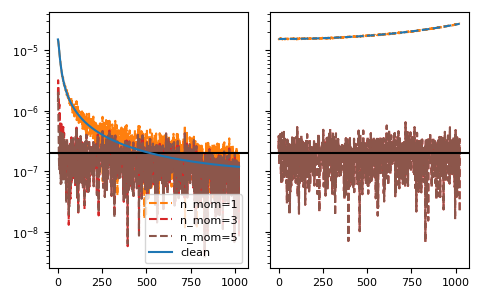gftool.fourier.tau2iw¶
-
gftool.fourier.tau2iw(gf_tau, beta, n_pole=None, moments=None, fourier=<function tau2iw_ft_lin>)[source]¶ Fourier transform of the real Green’s function gf_tau.
Fourier transformation of a fermionic imaginary-time Green’s function to Matsubara domain. We assume a real Green’s function gf_tau, which is the case for commutator Green’s functions \(G_{AB}(τ) = ⟨A(τ)B⟩\) with \(A = B^†\). The Fourier transform gf_iw is then Hermitian. If no explicit moments are given, this function removes \(-G_{AB}(β) - G_{AB}(0) = ⟨[A,B]⟩\).
- Parameters
- gf_tau(…, N_tau) float np.ndarray
The Green’s function at imaginary times \(τ \in [0, β]\).
- betafloat
The inverse temperature \(beta = 1/k_B T\).
- n_poleint, optional
Number of poles used to fit gf_tau. Needs to be at least as large as the number of given moments m. (default: no fitting is performed)
- moments(…, m) float array_like, optional
High-frequency moments of gf_iw. If none are given, the first moment is chosen to remove the discontinuity at \(τ=0^{±}\).
- fourier{
tau2iw_ft_lin,tau2iw_dft}, optional Back-end to perform the actual Fourier transformation.
- Returns
- gf_iw(…, (N_iv + 1)/2) complex np.ndarray
The Fourier transform of gf_tau for non-negative fermionic Matsubara frequencies \(iω_n\).
See also
tau2iw_ft_linBack-end: Fourier integration using Filon’s method
tau2iw_dftBack-end: plain implementation using Riemann sum.
pole_gf_from_tauFunction handling the fitting of gf_tau
Examples
>>> BETA = 50 >>> tau = np.linspace(0, BETA, num=2049, endpoint=True) >>> iws = gt.matsubara_frequencies(range((tau.size-1)//2), beta=BETA)
>>> poles = 2*np.random.random(10) - 1 # partially filled >>> weights = np.random.random(10) >>> weights = weights/np.sum(weights) >>> gf_tau = gt.pole_gf_tau(tau, poles=poles, weights=weights, beta=BETA) >>> gf_ft = gt.fourier.tau2iw(gf_tau, beta=BETA) >>> gf_tau.size, gf_ft.size (2049, 1024) >>> gf_iw = gt.pole_gf_z(iws, poles=poles, weights=weights)
>>> import matplotlib.pyplot as plt >>> __ = plt.plot(gf_iw.imag, label='exact Im') >>> __ = plt.plot(gf_ft.imag, '--', label='DFT Im') >>> __ = plt.plot(gf_iw.real, label='exact Re') >>> __ = plt.plot(gf_ft.real, '--', label='DFT Re') >>> __ = plt.legend() >>> plt.show()

Accuracy of the different back-ends
>>> ft_lin, dft = gt.fourier.tau2iw_ft_lin, gt.fourier.tau2iw_dft >>> gf_ft_lin = gt.fourier.tau2iw(gf_tau, beta=BETA, fourier=ft_lin) >>> gf_dft = gt.fourier.tau2iw(gf_tau, beta=BETA, fourier=dft) >>> __ = plt.plot(abs(gf_iw - gf_ft_lin), label='FT_lin') >>> __ = plt.plot(abs(gf_iw - gf_dft), '--', label='DFT') >>> __ = plt.legend() >>> plt.yscale('log') >>> plt.show()
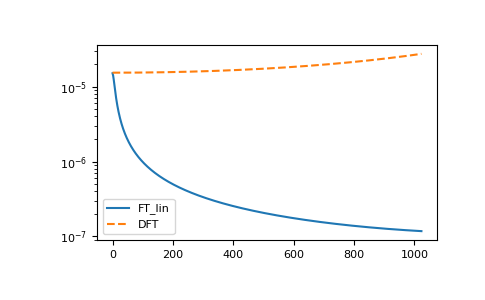
The accuracy can be further improved by fitting as suitable pole Green’s function:
>>> for n, n_mom in enumerate(range(1, 30, 5)): ... gf = gt.fourier.tau2iw(gf_tau, n_pole=n_mom, moments=(1,), beta=BETA, fourier=ft_lin) ... __ = plt.plot(abs(gf_iw - gf), label=f'n_fit={n_mom}', color=f'C{n}') ... gf = gt.fourier.tau2iw(gf_tau, n_pole=n_mom, moments=(1,), beta=BETA, fourier=dft) ... __ = plt.plot(abs(gf_iw - gf), '--', color=f'C{n}') >>> __ = plt.legend(loc='lower right') >>> plt.yscale('log') >>> plt.show()
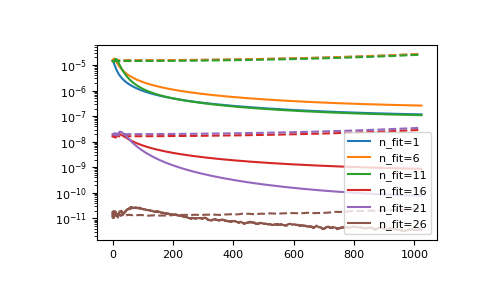
Results for DFT can be drastically improved giving high-frequency moments. The reason is, that lower large frequencies, where FT_lin is superior, are treated by the moments instead of the Fourier transform.
>>> mom = np.sum(weights[:, np.newaxis] * poles[:, np.newaxis]**range(8), axis=0) >>> for n in range(1, 8): ... gf = gt.fourier.tau2iw(gf_tau, moments=mom[:n], beta=BETA, fourier=ft_lin) ... __ = plt.plot(abs(gf_iw - gf), label=f'n_mom={n}', color=f'C{n}') ... gf = gt.fourier.tau2iw(gf_tau, moments=mom[:n], beta=BETA, fourier=dft) ... __ = plt.plot(abs(gf_iw - gf), '--', color=f'C{n}') >>> __ = plt.legend(loc='lower right') >>> plt.yscale('log') >>> plt.show()
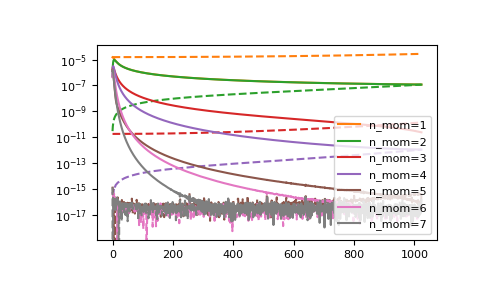
The method is resistant against noise:
>>> magnitude = 2e-7 >>> noise = np.random.normal(scale=magnitude, size=gf_tau.size) >>> __, axes = plt.subplots(ncols=2, sharey=True) >>> for n, n_mom in enumerate(range(1, 20, 5)): ... gf = gt.fourier.tau2iw(gf_tau + noise, n_pole=n_mom, moments=(1,), beta=BETA, fourier=ft_lin) ... __ = axes[0].plot(abs(gf_iw - gf), label=f'n_fit={n_mom}', color=f'C{n}') ... gf = gt.fourier.tau2iw(gf_tau + noise, n_pole=n_mom, moments=(1,), beta=BETA, fourier=dft) ... __ = axes[1].plot(abs(gf_iw - gf), '--', color=f'C{n}') >>> for ax in axes: ... __ = ax.axhline(magnitude, color='black') >>> __ = axes[0].legend() >>> plt.yscale('log') >>> plt.tight_layout() >>> plt.show()
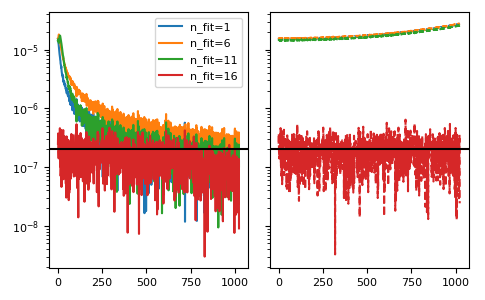
>>> __, axes = plt.subplots(ncols=2, sharey=True) >>> for n in range(1, 7, 2): ... gf = gt.fourier.tau2iw(gf_tau + noise, moments=mom[:n], beta=BETA, fourier=ft_lin) ... __ = axes[0].plot(abs(gf_iw - gf), '--', label=f'n_mom={n}', color=f'C{n}') ... gf = gt.fourier.tau2iw(gf_tau + noise, moments=mom[:n], beta=BETA, fourier=dft) ... __ = axes[1].plot(abs(gf_iw - gf), '--', color=f'C{n}') >>> for ax in axes: ... __ = ax.axhline(magnitude, color='black') >>> __ = axes[0].plot(abs(gf_iw - gf_ft_lin), label='clean') >>> __ = axes[1].plot(abs(gf_iw - gf_dft), '--', label='clean') >>> __ = axes[0].legend(loc='lower right') >>> plt.yscale('log') >>> plt.tight_layout() >>> plt.show()
